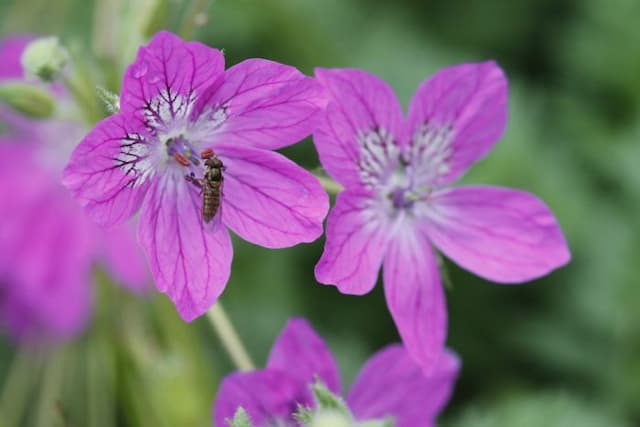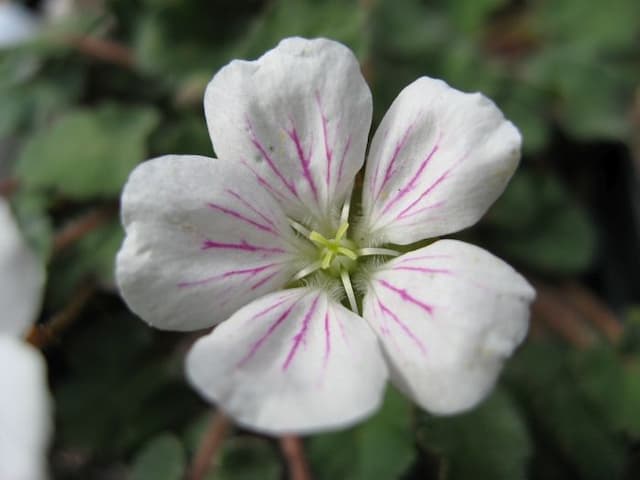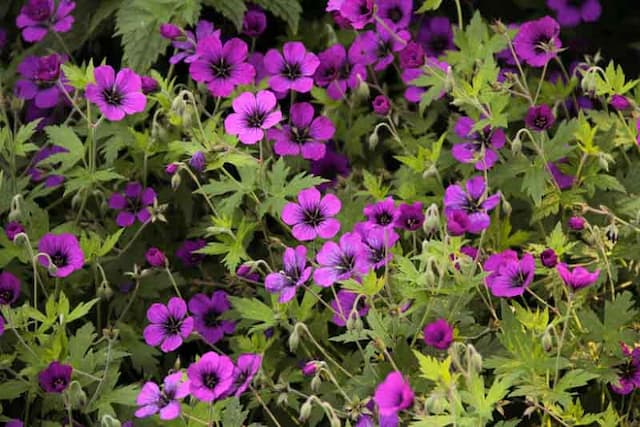Amethyst Pelargonium Pelargonium Amethyst = 'Fisdel' (PBR) (I/d)
![pelargonium [Amethyst]](/_next/image?url=https%3A%2F%2Fplants-admin.emdemapps.com%2Fimages%2Fplants%2F%2Fimages%2F604b583fd009c.png&w=3840&q=75)
ABOUT
The Pelargonium 'Amethyst', also commonly known as "Fisdel", is an eye-catching flowering plant adorned with lush green foliage. Each leaf is rounded with slight lobing and a hearty, robust appearance that provides a dense backdrop for the flowers. It emits a gentle, aromatic fragrance that is characteristic of many in its family. The blossoms themselves are striking, presenting in clusters atop slender stems that rise from the plant's core. The flowers are noted for their rich, vivid color, which is a blend of purples and pinks, reminiscent of an amethyst gemstone. They have a distinct form, with five petals that are slightly ruffled along the edges, giving them a full and somewhat lacy appearance. Two of these petals are distinctively marked with darker streaks or veins, adding a sense of depth and texture to the floral display. Depending upon the time of year and environmental conditions, the flowers can show variations in intensity of their purple-pink hues, but they always maintain a vibrant look that can liven up any garden space or container. The blooms stand out against the darker green of the leaves, creating a contrast that is both dramatic and appealing. Overall, the visual appeal of the Pelargonium 'Amethyst' ('Fisdel') lies in its lush, vibrant flowering which can catch the eye and become a focal point with its spectacular display of color and attractive foliage.
About this plant
 Names
NamesFamily
Geraniaceae.
Synonyms
Amethyst Ice Pelargonium.
Common names
Pelargonium Amethyst 'Fisdel', Pelargonium 'Fisdel'.
 Toxicity
ToxicityTo humans
Geraniums (Pelargonium group) are not considered highly toxic to humans. However, ingestion can cause minor symptoms such as vomiting, diarrhea, or an upset stomach. It is generally recommended to avoid eating any part of geranium plants.
To pets
Geraniums can be toxic to pets, especially to cats and dogs. If a pet ingests this plant, they may experience symptoms like vomiting, diarrhea, depression, and dermatitis. In particular, geraniums contain geraniol and linalool, which can be harmful to pets if ingested. It is advisable to keep these plants away from pets to prevent any accidental poisoning.
 Characteristics
CharacteristicsLife cycle
Perennials
Foliage type
Evergreen
Color of leaves
Varies
Flower color
Mixed
Height
1-2 feet (30-60 cm)
Spread
1-2 feet (30-60 cm)
Plant type
Herb
Hardiness zones
10
Native area
South Africa
Benefits
 General Benefits
General Benefits- Attractive Aesthetics: Features vibrant flowers and an appealing growth habit, enhancing garden beauty.
- Low Maintenance: Requires minimal care once established, making it a convenient choice for gardeners.
- Drought Tolerance: Can survive with limited water, ideal for dry climates and water conservation efforts.
- Pest Resistance: Naturally resists common pests, reducing the need for chemical treatments.
- Adaptability: Thrives in a variety of soil types and weather conditions, suitable for many gardens.
- Long Blooming Period: Provides a prolonged display of flowers, often throughout the warmer months.
- Attracts Pollinators: Welcomes beneficial insects like bees and butterflies, supporting biodiversity.
 Medical Properties
Medical Properties- This plant is not used for medical purposes.
 Air-purifying Qualities
Air-purifying QualitiesThis plant is not specifically known for air purifying qualities.
 Other Uses
Other Uses- Artistic inspiration – The vibrant colors and unique shape of pelargoniums can serve as inspiration for artists and crafters, influencing works of art, fabric designs, and more.
- Drying for potpourri – Pelargonium leaves and flowers, when dried, can be added to potpourri mixes to impart a pleasant fragrance to a room.
- Natural dye – The pigments in pelargonium flowers can be used to create natural dyes for fabrics or paper.
- Insect repellent sachets – Dried pelargonium leaves can be made into sachets that repel moths and other insects from closets and drawers.
- Floral arrangements – Fresh or dried pelargonium flowers can be used in floral arrangements to add color and a unique aesthetic touch.
- Culinary garnishes – Edible varieties of pelargonium flowers can be used as colorful garnishes for salads, desserts, and cocktails.
- Crafting bookmarks – Pressed pelargonium flowers and leaves can be used to create beautiful, natural bookmarks.
- Photography prop – Pelargonium plants can be used as live props in still life photography, adding organic beauty and a pop of color.
- Botanical illustration – Botanists and illustrators may use pelargonium plants as subjects for botanical drawings and plant studies.
- Educational tool – Pelargoniums can be used in schools or educational programs to teach botany and plant biology principles through observation and care.
Interesting Facts
 Feng Shui
Feng ShuiThe Pelargonium, commonly known as geranium, can be used in Feng Shui to create yang energy in the home due to its bright and colorful flowers which can promote happiness and positive vibes. Place it in areas that need increased energy or where you want to lift the spirits, such as a living room or balcony.
 Zodiac Sign Compitability
Zodiac Sign CompitabilityThe Pelargonium, or geranium, is not used in astrology practice.
 Plant Symbolism
Plant Symbolism- Comfort and Healing: Pelargoniums, commonly known as geraniums, often symbolize comfort due to their hearty nature and pleasant scent, which is believed to promote healing and soothe the soul.
- Friendship: Geraniums can represent close friendships or wishes for positive relationships, perhaps due to their long-lasting and colorful blooms which are reminiscent of enduring companionship.
- Happiness and Positive Energy: The bright blooms and uplifting aroma of geraniums are associated with happiness and the spread of positive vibes, making them ideal for lifting spirits.
- Protection: Some believe that geraniums have the power to ward off negative energies and evil spirits, thus they are often used in folk traditions to offer protection.
 Water
WaterThe plant commonly known as "Amethyst Improved" pelargonium should be watered deeply when the top inch of soil feels dry to the touch, which may be approximately once a week, depending on environmental conditions. During hotter and drier periods, more frequent watering may be necessary, possibly increasing to twice a week. Provide about one to two gallons of water per plant per watering session, ensuring that water penetrates deeply into the soil to encourage strong root development. During winter or cooler seasons, reduce watering to every other week as growth slows and the plant requires less moisture.
 Light
Light"Amethyst Improved" pelargonium thrives in bright, indirect light, but can also tolerate some direct sunlight, especially if it's during the cooler parts of the day. The best spot for this plant would be near a south-facing or west-facing window where it receives plenty of light without being exposed to the harshest midday sun, which could scorch its leaves.
 Temperature
TemperatureThe ideal temperature range for "Amethyst Improved" pelargonium is between 65 and 75 degrees Fahrenheit during the day and no lower than 50 degrees Fahrenheit at night. They can survive temperatures up to 80 degrees Fahrenheit but may require additional care at higher temperatures. It's important to protect these plants from frost, which can be damaging, so bringing them indoors or providing some form of frost protection is essential when temperatures start to dip.
 Pruning
Pruning"Amethyst Improved" pelargonium benefits from regular pruning to encourage bushier growth and to remove spent blooms and leggy stems. Prune these plants in late winter or early spring before new growth starts, which helps to stimulate fresh growth and more prolific flowering. It's usually enough to prune once a year, but occasional trimming of dead flowers and leaves can be done throughout the growing season to maintain plant health and appearance.
 Cleaning
CleaningAs needed
 Soil
SoilPelargonium 'Amethyst', commonly known as Martha Washington Geranium, thrives best in a well-draining soil mix composed of peat, perlite, and compost with a slightly acidic to neutral pH of 6.0 to 7.0.
 Repotting
RepottingMartha Washington Geraniums should be repotted annually to refresh the soil and accommodate growth, ideally in spring before the onset of the growing season.
 Humidity & Misting
Humidity & MistingMartha Washington Geraniums prefer moderate to slightly above average humidity levels, around 40-60%, but are adaptable to lower humidity conditions found in most homes.
 Suitable locations
Suitable locationsIndoor
Place in bright, indirect light and ensure proper drainage.
Outdoor
Place in part sun to light shade, protect from afternoon heat.
Hardiness zone
10-11 USDA.
 Life cycle
Life cycleThe Pelargonium Amethyst, commonly known as 'Mystery', begins its life cycle as a seed, which, once sown, germinates into a small seedling under adequate conditions of warmth and moisture. The seedling grows into a vegetative state where leaves and stems develop, becoming a young plant that can photosynthesize and grow steadily. With proper care, 'Mystery' reaches maturity and blooms, showcasing its distinctive purple flowers that attract pollinators and aid in the plant's reproductive process. After pollination, the flowers develop into seed capsules, eventually releasing seeds once they mature and dry, completing the reproductive cycle. In favorable climates, 'Mystery' can persist as an evergreen, continuing to grow and produce flowers for several years, although in colder regions, it may be treated as an annual or overwintered indoors. Over time, older plants may become woody and may require pruning or propagation through cuttings to rejuvenate and extend their life cycle.
 Propogation
PropogationPropogation time
Spring-Summer
The most popular method of propagating the Pelargonium Amethyst 'Fisdel', commonly known as the Amethyst Ice Geranium, is through stem cuttings. This is typically done in late summer to early fall. You will select a healthy, non-flowering stem and cut a piece about 4 to 6 inches (10 to 15 centimeters) long. Strip off the lower leaves to leave a clean stem, which can then be dipped in rooting hormone to encourage root development. The cutting should be inserted into a well-draining soil mix, ensuring the lower nodes where the leaves were removed are buried. Keep the soil moist but not waterlogged and place the cutting in a bright, indirect light location until it roots, which often takes a few weeks. Once the cuttings have rooted and begin to show new growth, they can be transplanted into individual pots or into the garden.









![Cranesbill [Rothbury Gem]](/_next/image?url=https%3A%2F%2Fplants-admin.emdemapps.com%2Fimages%2Fplants%2F%2Fimages%2F604b6243984c2.png&w=640&q=75)